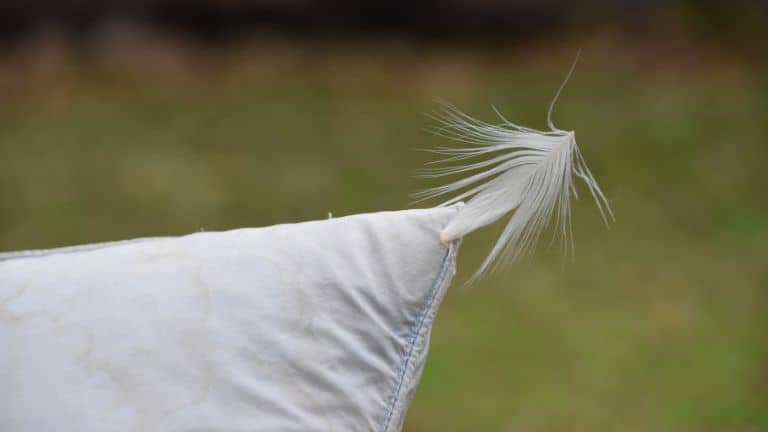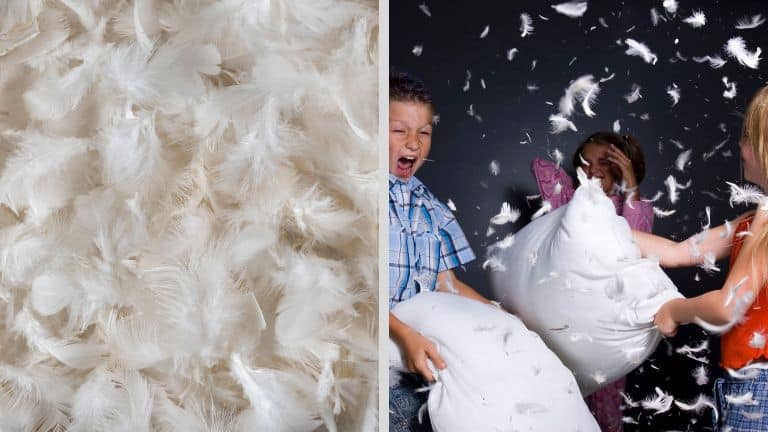Ever experienced fluff or down clusters coming out of your pillow?
Leaking feathers can be really annoying, and nobody wants down feathers stuck to their bedding.
In this article you’ll discover how to stop feathers from coming out of your pillows.
👉 You Might Also Enjoy: What To Do With Old Pillows?
LEGAL DISCLAIMER: This post may contain affiliate links. If you click an affiliate link and make a purchase, I may earn a commission. Also, as an Amazon Associate, I earn from qualifying purchases.
5 Easy Ways to Keep Feathers From Coming Out of a Pillow

Use a Pillow Protector
A pillow protector, essentially a tightly woven special pillowcase, is a must-have to keep your pillows clean and in good condition. These special covers are designed to fit under your regular pillowcases, serving as an extra layer of protection against dirt, oil, and sweat from our skin that could otherwise seep into the pillow. High-quality pillow protectors come with added benefits: they can stop feathers from escaping from your pillow and poking you during your sleep. In fact, certain protectors have been engineered with ultra-dense thread counts specifically to contain feathers and prevent leakage.
Keep Your Pillows Clean & Fresh – blocks dust mites, mold, mildew, pollen and pet dander.
But the benefits of a pillow protector aren’t exclusive to feather and down pillows. We strongly recommend using a pillow protector with all your bed pillows, regardless of their type. Beyond preventing premature wear and tear, these protectors serve a crucial role in safeguarding you from potential allergens like dust mites and bed bugs. This simple addition to your bedding can significantly improve the longevity of your pillows and the quality of your sleep.
Do Not Wash Too Frequently
Maintaining pillow hygiene is crucial for a clean and healthy sleep environment. Similar to sheets, pillows are prone to accumulating dirt, bacteria, and sweat, making it necessary to wash them periodically. Regular washing ensures your bedding stays fresh and clean. However, it’s essential to balance this cleaning need with preserving the longevity of your pillows.
Frequent washing, despite its benefits, can lead to incremental damage to the pillow fabric. (Read more: Can You Wash A Bamboo Pillow?) Over time, normal wear and tear will occur, irrespective of whether you wash your pillow. Still, the physical stress from frequent washing can accelerate this process, particularly for feather-filled pillows. The more often you wash them, the greater the chance of feathers poking out due to the weakened fabric. Therefore, while it’s necessary to wash your feather-filled pillows, it’s equally important to avoid over washing them. Only wash these pillows when absolutely necessary to maintain cleanliness without compromising their lifespan.
Fluff Your Pillow Regularly
Incorporating regular fluffing into your pillow care routine is a simple yet effective DIY solution to prevent feather leakage. Fluffing feather pillows daily, not just when they appear flat, helps redistribute the filling evenly. This avoids build-up in specific areas and thereby reduces the chances of leakage. Additionally, fluffing enhances the comfort of your pillows by maintaining their loft. Read more: Why Are Hotel Pillows So Comfortable?
However, it’s important to fluff gently to avoid creating new holes that could exacerbate leakage. For pillows that are already leaking, it’s advisable to avoid using a low heat dry cycle for fluffing. Although this method can help rejuvenate a pillow, it could potentially worsen leakage. Hence, hand-fluffing is the safer option for these pillows. Read more: How Do You Fluff A Bamboo Pillow?
Counterintuitively, fluffing can help contain the feathers inside the pillow. Even if a feather is on the verge of poking out, fluffing can help push it back into place. Hence, make fluffing a daily habit, and always be gentle to avoid disrupting the feathers. This quick daily routine can significantly reduce the risk of feathers escaping the next time you use the pillow.
Reinforce & Patch Ripped Seams
Reinforcing and patching ripped seams of your pillows is a straightforward and effective method to prolong their lifespan and prevent feather leakage. To reinforce the seams, you can sew a zigzag pattern over the original seam line using a needle and thread. Alternatively, you can sew a second seam either above or below the first one for extra strength. Seam reinforcing tape is another convenient option.
If feathers are escaping from a specific area on your pillow, it may be due to a thin spot, a small tear, or a ripped seam. In this case, patching up the area would be an appropriate solution. With a sewing needle, some thread, and a piece of fabric large enough to cover the troubled area, you can easily patch it up. For a ripped seam, simply sewing the separated ends together might suffice.
Regardless of your sewing skills, you can execute this task effectively. After all, the repair will be hidden under the pillowcase, so the primary goal is to fix the issue, not necessarily achieve aesthetic perfection. Various hand-sewing stitches are beginner-friendly, so it’s worth exploring different options to find one that suits the fabric condition best.

Spot Clean Your Pillow
Frequent washing can be harsh on pillows, causing them to wear out faster and increasing the risk of feather leakage. While most down and feather pillows are machine-washable, it’s advisable to resort to spot cleaning, especially if you’re dealing with leakage. Spot cleaning involves targeting specific soiled areas on your pillow instead of washing the entire pillow, preserving its integrity and preventing further leaks. Regularly washing the pillowcase and cover helps maintain overall cleanliness without damaging the pillow itself. This combined approach of spot cleaning the pillow and washing its coverings not only extends the pillow’s lifespan but also helps prevent the development of new or worsened leaks. For detailed spot cleaning tips, consider consulting a dedicated cleaning guide.
Best Practices for Keeping Pillows from Leaking In The Future
To safeguard against new shedding, whether you’ve recently patched up a leak or purchased new pillows, follow the tips below for effective prevention measures.

Use Caution & Treat Your Pillows with Care
Exercising caution and treating your pillows with care can greatly extend their lifespan and maintain their quality. Pillows, especially feather ones, should primarily be used for their intended purpose – sleeping. Engaging in pillow fights, using them as makeshift travel supports, or generally being rough with them accelerates their wear and tear. Feather pillows, in particular, tend to leak feathers as they wear out. The gentler your handling, the less likely they are to leak.
Unnecessary roughness weakens the outer fabric, making it easier for the delicate down feathers to poke through. Thus, it’s crucial to remember to use your pillows responsibly. Treat them gently and avoid pillow fights or other forms of misuse. This careful approach can significantly reduce the risk of feather leakage and prolong the useful life of your pillows.
Don’t Vacuum Pack Your Pillows
Vacuum packing may seem like a convenient storage solution for feather pillows, particularly during seasonal use or while moving. However, this method of compression can cause more harm than good. Vacuum sealing can exert pressure on the pillow, forcing feather quills to poke through the outer cover, leading to potential leakage. Hence, it’s advisable to refrain from vacuum packing your pillows. Instead, allocate enough space to store your pillows in their natural shape. This approach may require sacrificing some storage space, but it will protect the integrity of your pillows and prevent unnecessary damage.
Check Your Pillow Seams Regularly
Regular inspection of your pillow seams can prevent feather leakage, a common issue that often originates from these areas. Seams can quickly deteriorate if left unattended, leading to worsening leakage. Therefore, it’s recommended to check the seams each time you wash your pillowcases for signs of holes or wear. Any detected issues should be patched immediately to avoid further damage. This routine check not only prevents potential leakage but also extends the life of your pillows.
How To Stop Feathers From Coming Out Of Pillow – Final Verdict

Managing the prevention of feather leaks from your pillows involves a comprehensive approach that addresses various aspects of pillow care and maintenance. While regular pillow covers are an essential component, they may not fully prevent the escape of feathers from your pillows, especially in the case of feather bed pillows or down-filled pillows.
A feather-proof pillow protector is an effective tool in securing your pillow from future leaks, ensuring that your pillow stays clean and fluffy over time. Additionally, this preventive measure goes beyond simply addressing the aesthetic issue of stray feathers but also contributes to the overall hygiene of your bedding, reducing dust mite accumulation and potential allergens.
The type of pillow material also plays a significant role in its durability (Read more about types of pillows). Cheap pillows or those with synthetic fillings may not provide the same longevity as those filled with original feathers or memory foam. This is where proper maintenance comes into play, extending the pillow life beyond the standard 1-3 years.
Washing pillows should be done with care, using a mild detergent in warm water and following label instructions. However, frequent washing may prove a waste of time and lead to faster wear and tear, making spot cleaning a more desirable option. Drying cycles, too, must be approached with caution. Rather than relying on heat, consider a tennis ball or two in the dryer to keep your pillows fluffy.
For any signs of wear like lumpy pillows or small tears, even a simple sewing experience can go a long way. A fabric patch, ideally cambric cotton, sewn over the damaged area can prevent additional feather leaks. While you might not have fancy sewing supplies, a seam ripper and some extra fabric can be quite effective.
Lastly, remember that maintenance is not just about preserving your existing pillows but also about planning for the future. The cost of a feather-proof pillow protector or an additional pillowcase may seem like an additional cost now, but it could save you the trouble of frequently replacing your pillows, whether they’re for your bed or your couch cushions.
Preserving your pillows is a combination of consistent care, clever hacks, and understanding fabric technology. These efforts ensure that you get the best out of your pillows, keeping them clean, comfortable, and feather leak-free for as long as possible.
Frequently Asked Questions
Do I Need to Replace My Pillows If It’s Leaking Feathers?
No, feather leakage from pillows doesn’t always necessitate replacement. Often, feather leakage results from weakened seams or rough handling. Regular inspection of seams, patching any holes promptly, and treating your pillows gently can significantly reduce feather leakage. Also, consider using a pillow protector, which adds an extra layer of protection against feather leakage. Remember, pillows, especially feather ones, should primarily be used for their intended purpose – sleeping.
What is a Pillow Protector?
A pillow protector is a special cover, typically made with a dense weave, that fits over your pillow under the pillowcase. It serves to protect your pillow from dirt, bacteria, and allergens. More importantly, a high-quality pillow protector prevents feathers from leaking out of feather-filled pillows. Some pillow protectors are even designed with extra-dense thread-counts specifically to prevent feathers from leaking. We recommend using pillow protectors for all bed pillows, not just down and feather ones.
Can You Re-Stuff Pillows?
Yes, pillows can be re-stuffed when the filling becomes lumpy, flat, or starts leaking feathers. This is an excellent way to extend the life of your pillows without needing to replace them completely. When re-stuffing, ensure to use quality filling, be it down, feather, or synthetic alternatives. Take the opportunity to inspect and reinforce the seams, patch any holes, and ensure the filling is evenly distributed to prevent future leakage.
How Often Should You Buy New Pillows?
The frequency of buying new pillows largely depends on their quality, material, and your usage. On average, it’s advisable to replace pillows every one to two years. However, high-quality down or feather pillows can last up to ten years with proper care, including using pillow protectors, fluffing regularly, spot cleaning, and not vacuum packing. Regularly check your pillows for signs of wear, like lumpiness, discomfort, or increased allergy symptoms, to determine when it’s time to replace them.

